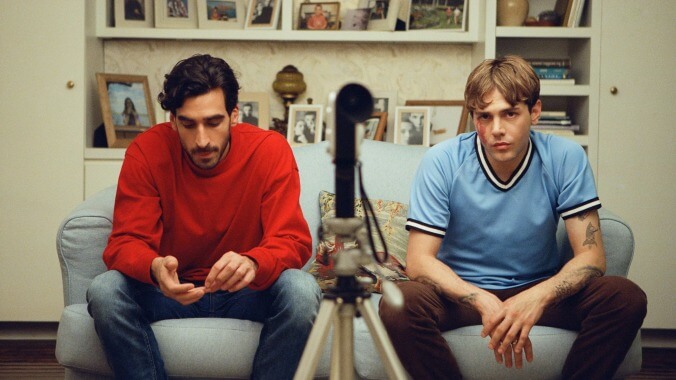Xavier Dolan finally says goodbye to youth in the wistful Matthias & Maxime


Since his international breakthrough with 2009’s I Killed My Mother, which he made at the age of only 19, Xavier Dolan has embodied a youthful cinema: impetuous, heartfelt, queer, and deeply aware. Now, with his eighth feature, the Quebecois filmmaker seems at last to be transitioning from the immediacy of youth to processing the memory of youth, a completely different emotional space. To use the most facile of analogies, if Dolan’s previous films represented his Brat Pack period, Matthias & Maxime is his St. Elmo’s Fire.
Verbal dudes in their 20s drink and drug, playing elaborate competitive word games and rattling off Harry Potter and Denys Arcand jokes even as signs of social and political fragmentation seep in around the edges. They’re partying at their friend Rivette’s family home, a T-shaped lakeside glass structure of translucent surfaces and opaque emotions. The first reel plays like a dynamite setup for a horror film—but in this case, the monster lurking just outside of frame would be adulthood, when friendships become something renegotiated on a daily basis and scheduling somehow becomes necessary to maintain bonds that were once constant and reliable. If adulthood is anything, it’s an epidemic of frustrations. And when these guys run into frustration, everything gets really loud and overlapping and they become The Goonies for a bit.
Marguerite Duras once said that “Silence is the brink upon which adulthood begins.” Here, that brink is doubt and regret. We know early on that Maxime (Dolan, starring in one of his own films for the first time since Tom At The Farm) and Matthias (Gabriel D’Almeida Freitas) had a tangle back in high school, making out at a party. Maxime is gay. Matthias is straight. No big deal. And the moment is common knowledge amongst their friends, not a forbidden secret. But when the two agree to appear in Rivette’s sister Erika’s short film, which requires them to kiss on camera, their emotions get… timeslippy. How do you renegotiate intimacy years down the road?
Even though she kickstarts the film’s drama, Erika (Camille Felton) is ridiculed by the older houseguests for being active on social media and polyglot in speech. The mockery reads, perhaps, as an echo of the shade Dolan took from previous generations of directors and critics, who didn’t appreciate what his films brought to the table. Anyway, Erika gets the last laugh by proclaiming sexual labels an antiquated concept. There is a certain throwback vibe to Matthias & Maxime, familiar to anyone who’s been to LGBTQIA+ film festivals or who has paid attention to queer art dealing with repression over the past few decades.
Despite the title, Matthias & Maxime keeps the two characters separated for much of its runtime. The ticking clock at center is Maxime’s upcoming move to Australia, an imminent departure that lurks beneath the surface of every interaction. Matthias’ future is the business world, all corporate drag in blue and chrome. He’s got a lady, Sarah (Marilyn Castonguay), who seems to love him and who can cut to the chase regarding the barriers he’s building; we sadly do not get enough of her. We do get Beach Rats’ Harris Dickinson, delivering a three-scene burlesque culminating in a Britney Spears-scored strip club dawdle that should get Bret Easton Ellis’ attention.
Maxime is dramatically shortchanged with a protean toxic stew of codependency waiting for him whenever he visits his mother’s home. This is absolutely a Dolan film, where an A-bomb of emotional chaos is never truly far away. There are troubled mothers in abundance, with Mommy’s Anne Dorval embodying the unpredictable while smoking like Sarah Palmer. A mid-film gathering of moms is a summit of shit-talking Skeksis guzzling cocktails in a meticulous green dining room, and it bears mentioning that sometimes Dolan’s films seem to really enjoy being angry at women just as his body of work aims to dismantle the stereotype of the mellow and chill Canadian.
The director’s instincts for utilizing shifting aspect ratios continue to yield visceral results. Throughout the film, he uses portrait mode to signify distance (physical and emotional) and voyeurism. There’s also something rapturous about a late shift into cinemascope, when Matthias and Maxime reunite and finally confront what’s going on between them. The needledrop is of a Phosphorescent song, but the whole sequence feels like one of those easy silences The Chicks sung about, where being wholly alive and part of the lives of others is no longer a competition, just a reflex. This is a film with big emotions and swoon-worthy wet hair moments, and it finds unexpected places in the subconscious to settle.